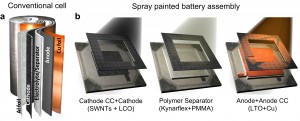Spray-on battery, 3D printing
 Rice University demos a process to spray-on batteries. This is Another step towards fully automated fabrication.
Rice University demos a process to spray-on batteries. This is Another step towards fully automated fabrication.
It was easy to predict that 3D printing would be able to make electronic parts. The process Rice uses probably doesn’t actually need 3D printing to work but it fits the concept. Multiple layers of different materials are sprayed on a surface to create a battery.
Circuits are already being made using normal 2D printers by varying the thickness of the traces to create resistors and conductors. By using a 2 or 3 different materials the full range of electronic parts could be printed directly into the circuit so a robot could literally print a copy of itself. Stratasys and Optomec have already printed electronics.
The spray-on battery will make it easier to build batteries of different shapes and sizes. It will also make it possible for nearly anyone to make batteries anywhere in the world. This can drastically reduce the real costs in terms of time and materials.
Learn how to program a robotic car in 7 weeks
Two years ago in “Why We Don’t Have Flying Cars, Yet” I explained why automation is the next big innovation for vehicles, not alternative energy.
Standford is offering a 7 week undergraduate class teaching how to program a self-driving car. Automation improves the under-satisfied outcome of cars but it is also technologically easier to make than low-cost long range batteries for an electric car.
The Predictive Innovation report the video was based on was first offered to GM but they turned it down. European and Asian car companies used the information and are now selling cars with automated driving features.
 Volvo’s XC60 has a City Safety feature that automatically brakes to prevent crashes. It’s a pure gasoline car with lots of room and power. It is priced about the same as the Chevy Volt, although doesn’t receive any of the government incentives.
Volvo’s XC60 has a City Safety feature that automatically brakes to prevent crashes. It’s a pure gasoline car with lots of room and power. It is priced about the same as the Chevy Volt, although doesn’t receive any of the government incentives.
| 2011 US Car Sales | |
| Car | Units Sold |
| Chevy Volt | 7,671 |
| Volvo XC60 | 12,932 |
The Volvo XC60 with City Safe automatic braking sold 68% more cars in the USA than Chevy Volt. So not only was it easier to build, and thus more profitable, it sold more units. The automated car is more desirable to customers. One of the key points of the report was to offer incremental improvements with meaningful value to customers. That made sure the new features were high quality and low cost.
In addition to satisfying safety, automated cars are better for the environment than an electric car. Electric cars just shift the source of pollution from burning gasoline in the car to burning coal at a power plant. Automated cars use less energy.
First, replacing or repairing a car damaged in an accident uses more energy than the car ever will from driving it. And how can you count the cost of injuries and deaths?
Secondly, by reducing traffic congestion automated cars can save energy for all the cars on the road while reducing drive times and frustration.
Automation in vehicles is still a big innovation opportunity.
Robot Strawberry Picker, Abundance Report
In the USA picking strawberries is hard low paid work for migrant, often illegal alien, workers. Japan’s robot strawberry picker comes from a different mindset.
Most post-industrialized nations complain about cheap foreign labor taking their jobs. Similarly people living in high income nations complain that automation is eliminating jobs, even jobs no one really wants to do. Standing in the hot sun bending over picking strawberries for 12 hours per day is not desirable work for any person.
Japan values their national cultural identity much more than other post-industrialized nations. Being a small island nation they are very concerned about depending on foreigners for materials. Japan understands and values self-sufficiency. Additionally, Japan is an aging society. The ratio of young people who are able to do manual labor is declining. If Japan is going to remain self-sufficient it must find ways to do more with less human labor.
Japan’s obsession with automation stems from their need to do more with less. Proper design and automation is how Japanese companies increase productivity and quality while reducing costs.
Even though Japan is a small nation it produces a great deal of food, particularly for local use. Rather than using the mass production approach of the nations with large amounts of land such as the USA, Canada, and Russia, Japan produces food in super efficient small scale farms. These types of farms are particularly well suited to automation. A small family owned farm using automation can produce much more food per acre and at much higher quality than the large scale industrial farming approach. Rather than viewing automation as stealing jobs, the Japanese are spreading real wealth by allowing more people to directly own and operate the means of production.
Japan is moving forward into Abundance both technologically and socially. Other nations and people could learn a lot from the Japanese.



 Predictive Innovation Training
Predictive Innovation Training Predictive Innovation: Core Skills Book
Predictive Innovation: Core Skills Book RoundSquareTriangle.com
RoundSquareTriangle.com